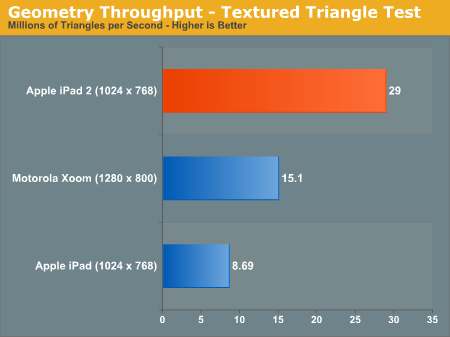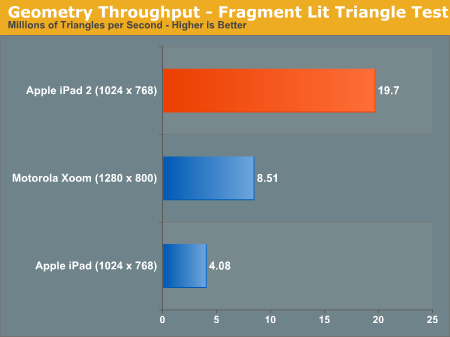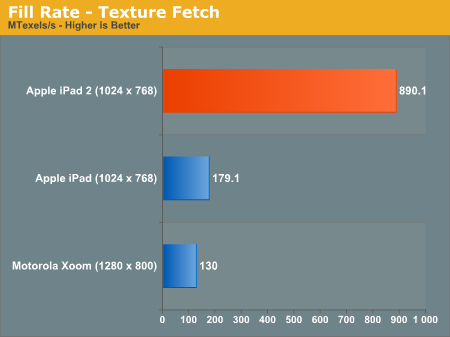Apple iPad 2 GPU Performance Explored: PowerVR SGX543MP2 Benchmarked
by Anand Lal Shimpi on March 12, 2011 3:04 PM EST- Posted in
- Smartphones
- Apple
- iPad
- GLBenchmark
- iPad 2
- Mobile
- Tablets
Earlier this morning we published our first impressions on Apple's iPad 2, including analysis on camera quality and a dive into the architecture behind Apple's A5 SoC. Our SoC investigation mostly focused on CPU performance, which we found to be a healthy 50% faster than the A4 in the original iPad - at least in web browsing. We were able to exceed Apple's claim of up to 2x performance increase in some synthetic tests, but even a 50% increase in javascript and web page loading performance isn't anything to be upset about. We briefly touched on the GPU: Imagination Technologies' PowerVR SGX 543MP2. Here Apple is promising up to a 9x increase in performance, but it's something we wanted to investigate.
Architecturally the 543MP2 has more than twice the compute horsepower of the SGX 535 used in Apple's A4. Each shader pipeline can execute twice the number of instructions per clock as the SGX 535, and then there are four times as many pipes in an SGX 543MP2 as there are in a 535. There are also efficiency improvements as well. Hidden surface removal works at twice the rate in the 543MP2 as it did in the 535. There's also a big boost in texture filtering performance as you'll see below.
As always we turn to GLBenchmark 2.0, a benchmark crafted by a bunch of developers who either have or had experience doing development work for some of the big dev houses in the industry. We'll start with some of the synthetics.
Over the course of PC gaming evolution we noticed a significant increase in geometry complexity. We'll likely see a similar evolution with games in the ultra mobile space, and as a result this next round of ultra mobile GPUs will seriously ramp up geometry performance.
Here we look at two different geometry tests amounting to the (almost) best and worst case triangle throughput measured by GLBenchmark 2.0. First we have the best case scenario - a textured triangle:

The original iPad could manage 8.7 million triangles per second in this test. The iPad 2? 29 million. An increase of over 3x. Developers with existing titles on the iPad could conceivably triple geometry complexity with no impact on performance on the iPad 2.
Now for the more complex case - a fragment lit triangle test:

The performance gap widens. While the PowerVR SGX 535 in the A4 could barely break 4 million triangles per second in this test, the PowerVR SGX 543MP2 in the A5 manages just under 20 million. There's just no competition here.
I mentioned an improvement in texturing performance earlier. The GLBenchmark texture fetch test puts numbers to that statement:

We're talking about nearly a 5x increase in texture fetch performance. This has to be due to more than an increase in the amount of texturing hardware. An improvement in throughput? Increase in memory bandwidth? It's tough to say without knowing more at this point.
| Apple iPad vs. iPad 2 | ||||
| Apple iPad (PowerVR SGX 535) | Apple iPad 2 (PowerVR SGX 543MP2) | |||
| Array test - uniform array access |
3412.4 kVertex/s
|
3864.0 kVertex/s
|
||
| Branching test - balanced |
2002.2 kShaders/s
|
11412.4 kShaders/s
|
||
| Branching test - fragment weighted |
5784.3 kFragments/s
|
22402.6kFragments/s
|
||
| Branching test - vertex weighted |
3905.9 kVertex/s
|
3870.6 kVertex/s
|
||
| Common test - balanced |
1025.3 kShaders/s
|
4092.5 kShaders/s
|
||
| Common test - fragment weighted |
1603.7 kFragments/s
|
3708.2 kFragments/s
|
||
| Common test - vertex weighted |
1516.6 kVertex/s
|
3714.0 kVertex/s
|
||
| Geometric test - balanced |
1276.2 kShaders/s
|
6238.4 kShaders/s
|
||
| Geometric test - fragment weighted |
2000.6 kFragments/s
|
6382.0 kFragments/s
|
||
| Geometric test - vertex weighted |
1921.5 kVertex/s
|
3780.9 kVertex/s
|
||
| Exponential test - balanced |
2013.2 kShaders/s
|
11758.0 kShaders/s
|
||
| Exponential test - fragment weighted |
3632.3 kFragments/s
|
11151.8 kFragments/s
|
||
| Exponential test - vertex weighted |
3118.1 kVertex/s
|
3634.1 kVertex/s
|
||
| Fill test - texture fetch |
179116.2 kTexels/s
|
890077.6 kTexels/s
|
||
| For loop test - balanced |
1295.1 kShaders/s
|
3719.1 kShaders/s
|
||
| For loop test - fragment weighted |
1777.3 kFragments/s
|
6182.8 kFragments/s
|
||
| For loop test - vertex weighted |
1418.3 kVertex/s
|
3813.5 kVertex/s
|
||
| Triangle test - textured |
8691.5 kTriangles/s
|
29019.9 kTriangles/s
|
||
| Triangle test - textured, fragment lit |
4084.9 kTriangles/s
|
19695.8 kTriangles/s
|
||
| Triangle test - textured, vertex lit |
6912.4 kTriangles/s
|
20907.1 kTriangles/s
|
||
| Triangle test - white |
9621.7 kTriangles/s
|
29771.1 kTriangles/s
|
||
| Trigonometric test - balanced |
1292.6 kShaders/s
|
3249.9 kShaders/s
|
||
| Trigonometric test - fragment weighted |
1103.9 kFragments/s
|
3502.5 kFragments/s
|
||
| Trigonometric test - vertex weighted |
1018.8 kVertex/s
|
3091.7 kVertex/s
|
||
| Swapbuffer Speed |
600
|
599
|
||
Enough with the synthetics - how much of an improvement does all of this yield in the actual GLBenchmark 2.0 game tests? Oh it's big.











219 Comments
View All Comments
ncb1010 - Sunday, March 13, 2011 - link
Tablet is a form factor which both the Kindle reader and the iPad share. It has nothing to do with the screen tech involved or the software used.sean.crees - Sunday, March 13, 2011 - link
Tablet is not just a form factor. If that is your argument, then technically a magazine is the same "form factor", so then we must include all issued magazines.A tablet is an experience, one you cannot get on an e-reader, a magazine, a smartphone, a notebook, a PC etc etc etc. It is a unique device with its own unique segment.
Tablets include devices like Ipad, Ipad2, Xoom, Touchpad etc etc.
solipsism - Sunday, March 13, 2011 - link
You can install the Kindle app on Windows and Macs, too. I guess that makes them eReaders which you also classify as tablets, which makes the iPad marketshare under 5%. OMG APPLE IS TEH SUXS!!!1 :\ncb1010 - Sunday, March 13, 2011 - link
Umm, are we talking desktop computer Mac/Windows computers? Or are we talking notebook clamshells? tablet is a physical form factor. It has nothing to do with if it runs Kindle on Mac/Windows or not.djgandy - Sunday, March 13, 2011 - link
Yeah one product sells 3 times more than an entire group of products.So all the products in the 27% combined should get 1/3rd of the review time of the iPad.
Ringer9 - Saturday, March 12, 2011 - link
Um, "4 times more popular" means 5 times as popular. Also, as ncb1010 said, 27% to 73% is much closer to a 1:3 ratio, so the iPad is roughly 2 times more popular than other tablets. In other words, you don't know what you're saying.rquick - Sunday, March 13, 2011 - link
The multiple in 1:3 is 3, as in "3 times more popular." And 4 times more popular really does mean 4 times not 5. It is pretty simple math really. I thin what you meant was that 4 times more popular means 4 out of 5. As if it really matters. The actual multiple isn't as important as the fact that one single device is more popular than the entire remainder of the market put together, even if you try to pad the market numbers with single purpose devices that are clearly not meant to compete in that market (dedicated e-readers). The color Nook should probably be included though.ncb1010 - Sunday, March 13, 2011 - link
The Kindle runs apps and has an app store...so, I don't see how it is truly "dedicated". That device alone accounts for 7 million sales in 2010 which puts a big chink out of iPads 73% market share(calculated not counting Kindles) as it sold 15 million in 2010.Azethoth - Saturday, March 12, 2011 - link
No, the iPad market share was over 90%. (Apple counts units actually sold to customers vs other manufacturers counting units sold to stores who may sell to customers later on so stats are approximate).Consensus expectations are it will drop to 80% share this year and possibly drop from the #1 spot in 2014 or so.
However, this review makes me question such a large drop. Android software looks like it will not be competitive till summer, and the Xoom is faring poorly in the benchmarks. Maybe if someone else produces an Android standard bearer.
My head wants to tell me Apple is making the classic Mac vs PC mistake here by not being "open", but my gut is telling me things are just not the same in this space.
rquick - Sunday, March 13, 2011 - link
You "gut" is exactly correct. The world of tablets is not the same as the world of general purpose pcs. Just like the argument about tablets versus netbooks. Apples to oranges (pun unintentional). When people pick up a tablet, most of them do not expect or need the full complexity of a computer os. I have been using an iPad for several months now and I do not even notice that I am "missing" 40% of the internet. I suspect that number is still wildly inflated and falling fast. But the point is that I don't miss flash at all. The one thing I do miss is the lack of a file system. But most users don't.